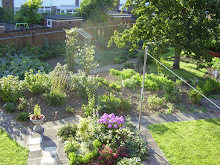American pioneers from the time of the Mayflower cultivated and used herbs for everything from seasoning to cures for illnesses to making perfumes. As time went on and dried herbs became more readily available, herb cultivation fell out of practice. Current medical technology doesn’t rely directly on treatment with specific herbs. The cosmetic and perfume industries manufacture most of the lotions, soaps and perfumes. However, In the last couple of decades ethnic foods have become fashionable and people are beginning to cultivate herbs again.
Successfully growing herbs depends on properly managing the following:
1) Location2) Soil3) Site preparation4) Drainage5) Pest Containment
The first step to successful herb gardening is deciding on the site. Size depends on the variety of herbs you wish to cultivate. A good size for a kitchen garden site should be about 4 feet by 20 feet. Diagram the area and label each segment for the herb you wish to grow. Be sure to separate the annual and perennial herbs.
When selecting a site, drainage is the most important feature. Herbs will not grow in wet soil. The soil need not be especially fertile. Very fertile soil will grow big plants without much flavor. The soil should be essentially neutral, neither heavy on the acid nor alkaline. If, however, the soil does not drain well, remove 15 to 18 inches of soil and put in a 3 inch layer of gravel and replace the soil. The soil will now drain more efficiently. A ph factor of around 6.5 produces excellent herbs.
Once the soil has been selected and proper drainage is ensured; it is time to prepare the soil. Remove 12 to 18 inches of the top soil. Make sure the sub soil is not hard or compacted. If it is, work in sphagnum peat or organic material to loosen it up. Mix the top soil with sphagnum peat and sand or composting material to make certain it is workable and will maintain moisture. Replace the top soil with a few inches more than was taken off to allow for the garden to settle once it is planted.
Be on the lookout for garden insects and or diseases. Aphids, spider mites, grass hoppers, caterpillars, and rust can come your way. Be sure to treat for these pests and diseases at the first sign of infection. Don’t allow any of them to get the upper hand and ruin you herb garden.
Herb gardening is easy as long as you follow a few directions and take the steps necessary to ensure success. Be sure to plan you garden first, then select the for location, size, and soil features. Once these tasks have been successfully accomplished, prepare the site by assuring proper drainage. Make certain the subsoil and top soil are prepared with adequate organic materials and control the pests and plant diseases.
Herb gardening is fun and provides a sense of accomplishment. Also, herb gardening provides you with fresh herbs for food preparation in your kitchen. No more of those dried herbs.
Steve Buchanan writes article on many topics including Honda Lawn Mowers, Honda Generators and Snow Blower
Article Source:
http://www.free-articles-zone.com/ 




No comments:
Post a Comment